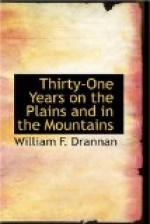That day we took the divide between Carson and Humboldt, south of the emigrant trail, making a ride of forty miles that day, and then a dry camp—a camp without water. The following morning we rode about five miles, and came on to a big Indian trail that had been made the evening before. We pushed on as fast as we could, all the time keeping a sharp lookout, for we were now in the heart of the Pah-Ute country, and could not be too careful. About half past three o’clock we came to where the Indians had camped the night before, on a tributary of the Humboldt. At this camp three antelope had been devoured, so we knew that there had been a large band of the redskins at that feast. It was also evident that they were not very far ahead of us, as their fires had not entirely died out.
Continuing the pursuit we were now getting close to the emigrant trail, and it was plain that the Indians had headed west, which convinced me that they were looking for emigrants, and if so they would not go far before they would either go into camp or leave the trail. It proved that after following the emigrant train a short distance they had taken to the hills. The country was a sea of sagebrush, and frequently we would start a jack-rabbit or antelope that we would have been pleased to roast for supper, but dared not shoot.
When near the top of a hill I would dismount, and leaving my horse with Meyers, would crawl to the summit of the hill and peep over in order to discover whether or not the Indians were in sight, and then return, mount my horse and ride at a rapid gait until near the top of another hill, when the same maneuver would be repeated.
At last we came to a sharp ridge and I dismounted. I remarked that if we did not find those Indians soon we would have to make another dry camp that night. It was now nearly sunset, and on crawling to the top of the ridge and looking down on a nice little valley not more than a half-mile distant, I saw that they had just gone into camp and had not yet got all their ponies unpacked.
I had a good chance to make a rough estimate of their number, which I thought to be about two hundred warriors.
I rushed back to Meyers and told him that I had located them, and that one of us would have to ride back to headquarters that night and report, and asked him whether he would rather go or stay and watch the Indians.
“Why not both go,” he asked.
I told him that by the time the cavalry could get there the Indians might be gone, and one of us must stay and see where they went to.
We were now, as near as we could tell, about thirty-five miles from camp, as that afternoon we had been traveling west, in the direction of headquarters.
After thinking the matter over, Meyers concluded that he would rather make the ride than stay. I told him to be off at once, but before starting, he said to me: “Suppose the Indians should discover you while I am away?”




